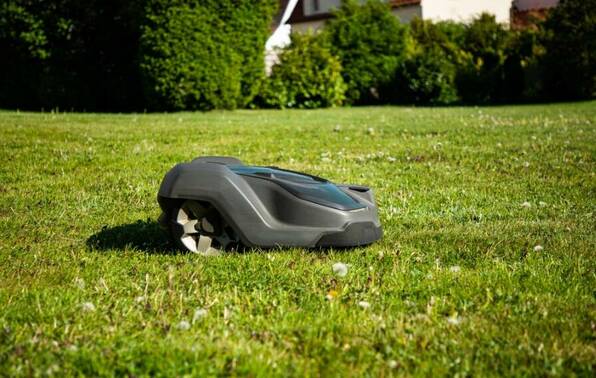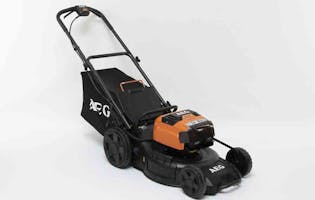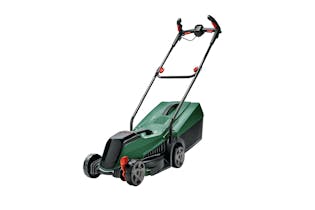How to choose the best lawn mower
Learn how to buy the best lawn mower for your backyard. Our guide discusses the different types of lawn mowers and features to look for when choosing a lawn mower.
Before you compare lawn mower ratings, consider the pros and cons of the different types of lawn mowers and the features to look for. This will help you choose the right lawn mower to buy for your lawn and budget.
Lawn mower types

Petrol lawn mowers
Performance
Petrol lawn mowers with decent-sized engines (160cc+) develop more torque (rotational force) at max blade speeds than electric models. This means in dense, long grass, a good petrol mower is less likely to slow or stall.
While we don’t recommend mowing grass when it’s wet, petrol lawn mowers are better than battery models at packing the catcher if the turf’s damp.
Mulching
Most petrol lawn mowers, even budget models, can mulch. This means they come with a plug that you put in the catcher chute to recirculate clippings through the blades, turning them into a fine mulch.
Modern petrol mowers have dual-purpose blades (catch and mulch), meaning you only need to insert the plug to switch between modes.
Ease of use
Petrol lawn mowers are harder to use than electric models. Most have a pull cord start, which can take a few yanks to get going when it’s cold. They’re heavier, much louder and produce fumes. Modern four-stroke lawn mowers are quieter and run much cleaner than two-stroke models, and you don’t need to mix petrol and oil. Petrol lawn mowers need regular maintenance and servicing, including spark plug and oil changes.
Running costs
Petrol lawn mowers are more expensive to run than battery-powered mowers. You might spend $50–$100 in petrol each summer, plus the costs of regular maintenance and servicing.
Cutting height
Petrol lawn mowers generally offer the widest range of cutting heights and can usually cut grass shorter – as low as 5mm or 10mm. But be aware that the lawn mowers of some brands only cut down to 25mm–45mm.
Running time
A big drawcard of petrol lawn mowers is their infinite running time, as long as you’ve got petrol.
Reliability
The four-stroke engines of petrol lawn mowers operate at high temperatures, so they need regular maintenance and servicing like a car. However, modern models are relatively reliable.
Battery-powered lawn mowers

Performance
Battery-powered lawn mowers (sometimes called cordless lawn mowers) produce less torque than petrol mowers. But our recommended models are powerful enough to give most lawns a tidy finish, even when cutting longer grass. You’ll usually only notice a lack of power when cutting damp or very long (200mm+) grass or weeds.
Mulching
Most of our recommended battery-powered lawn mowers are mulch and catch. And their performance is often as good as their petrol counterparts.
Ease of use
While some battery-powered lawn mowers can weigh over 30kg, most are 10kg–15kg lighter than petrol lawn mowers, making them much easier to handle. They’re also quieter, have lower levels of vibration, start at the push of a button, and don’t require much maintenance.
Running costs
Cordless lawn mower batteries only cost about 10¢ to recharge. You won’t have to pay $50–$100 in petrol each summer, or the costs of the regular servicing and maintenance required for petrol lawn mowers. But you’ll need to get the blades sharpened from time to time.
And you’ll need to replace the battery after 3–5 years, as they gradually lose capacity over time.
But you can save money when buying other tools as lawn mower batteries can typically be used in several products within the manufacturer’s range, such as leaf blowers and line trimmers. Buying the “skin” (tool only) is cheaper than buying a kit that includes the tool (lawn mower), battery and charger.
Cutting height
Most battery-powered lawn mowers only cut down to about 25mm – petrol lawn mowers can usually cut shorter.
Running time
This is the limiting factor for cordless lawn mowers. The average run-time for the models we’ve tested is about 50 minutes. But there are many that’ll only run for 35 minutes or less (some only about 20) before needing to be recharged.
Reliability
Battery-powered lawn mowers have fewer moving parts than petrol mowers, so they’re more reliable. But you’ll eventually need to replace their batteries.
Mains-electric lawn mowers

Performance
We haven’t recently tested any mains-electric lawn mowers (sometimes called corded lawn mowers), but we continue to monitor the market. The electric lawn mowers we previously tested didn’t perform as well as the battery-powered and petrol mowers. They give a more ragged cut than other lawn mowers and struggle in tough conditions.
Mulching
Corded lawn mowers typically cut or catch only (“cut” means mowing without a catcher or mulching plug, so thick clumps of grass are returned to the lawn surface). However, some mains lawn mowers cut quite finely on the first pass and recirculate some of the clippings through the blades, offering a pseudo-mulching effect.
Ease of use
Mains-electric lawn mowers are typically the lightest. They’re also quiet and easy to start. But dragging a power cord can be a hassle. Always use an RCD (residual-current device) plug to avoid a shock in case you accidentally cut the cord.
Price
Corded lawn mowers are usually the cheapest, aside from hand lawn mowers. They’re simple units with no expensive battery, charger or engine.
Cutting height
The mains-electric lawn mowers in our previous tests didn’t cut as low as petrol models.
Running time
Mains-electric lawn mowers theoretically have no run-time limit. But they’re not designed for big jobs and can overheat if used for long periods.
Reliability
With no batteries and very few moving parts, mains-electric lawn mowers are the most reliable type of lawn mower.
Push lawn mowers

Push lawn mowers have no engine. They’re inexpensive, cheap to run, lightweight, compact, quiet, require little maintenance and they don’t require a power source. But they're not practical for large or sloping lawns, or for cutting long grass.
To get a consistent cut with a push lawn mower, you need to keep the blades sharp and properly adjusted. You also need to mow regularly, before the grass gets too long.

The ride-on alternative
Bought a few more acres than a regular mower can handle? Ride-on mowers cut a wide swathe of grass – anywhere from 700mm to over 1m.
Lawn mower features
Body (chassis) material
An alloy lawn mower body is more expensive than others. It’s corrosion resistant and likely to last longer in damp conditions – although it won’t last as well in sandy areas because sand wears away the aluminium.
A steel body is cheaper but it’ll rust unless cleaned and dried after every use. However, it’ll only dent if bumped into a large rock, whereas an alloy body can crack.
Plastic is lightweight and doesn't corrode, but a plastic body might not last as well if regularly pounded by stones and other debris. A plastic lawn mower body is more suitable for well-tended lawns where there’s minimal chance of contact with stones and rocks.
Handle
A turned-up handle is usually easiest to use. It’s also helpful if the height is adjustable. The lawn mower’s handle should fold easily for storage.
Throttle control
A lawn mower’s throttle control is located on the mower’s handlebar for quick and easy access. It shouldn't be stiff.
Cutting height
Look for a large number of cutting heights and make sure the lowest setting is suited to your needs. It should be easy to change the cutting height using one lever acting on all four wheels.
Catcher
Lawn mower catchers can be either solid plastic or partly mesh. Rigid plastic is heavier but stronger than the mesh type, which can also allow dust to blow over the user. The catcher should have two handles – one for carrying and the other for emptying. It should be easy to remove and replace.
Engine maintenance (petrol lawn mowers)
Petrol lawn mower engines need servicing just like a car. Check how easy it will be to change the oil, air filter and spark plug. You need to keep an eye on the oil level and service it according to the manufacturer’s instructions. You should change the oil at least annually.
Starter cord (petrol lawn mowers)
Some lawn mowers have the starter cord on the handle, so you use your arm and perhaps upper body to operate it. Others have the cord down on the engine casing, requiring a full body pull. Neither guarantees an easy start. Before you buy a lawn mower with a starter cord, ask to try it out in the shop.
Some cords are located on the upper handle, which restricts the pulling action more than those placed further down. Left-handers may find it harder to use a starter cord on the lawn mower’s upper handle.
Wash port
Look for a hole on top of the lawn mower’s body, designed to connect a hose, for easy cleaning underneath.
Noise
There's no such thing as a quiet petrol lawn mower, but some are noisier than others. Check the vibration as well.
Easy push
Ball-bearing wheels make pushing easier. Self-propelled lawn mowers are very easy to push, but they’re more expensive too.
Mulching or standard?
Mulching lawn mowers have a specially shaped cutting blade and a catcher-chute plug. With the catcher removed and the plug inserted, the clippings are spun under the body and chopped up further by the blade. They are then blown down into the lawn, leaving a smoothly mown surface.
For successful mulching, the grass can’t be too short or too long. Cut too short and there won’t be a carpet of grass for the mulch to sink into and decompose. Left too long after cutting and the mulch will form clumps on the lawn – especially if the grass is wet. Also note that the length of the cut shouldn’t be more than 25mm.
Mulch and catch lawn mowers are the most versatile. With the catcher attached and mulching plug removed, they can be used as a conventional catcher-only lawn mower. Mulcher-only lawn mowers don’t have a catcher – they operate in mulching mode only.
Check our lawn mowers reviews to see which lawn mowers have the features you want.
Buying a secondhand lawn mower
You might save money buying a secondhand lawn mower, but there are some things to check first:
- Type of lawn mower: Consider the pros and cons of the different types of lawn mowers. Some are easier to use and maintain but may not be suitable for large yards or long grass. The battery in a battery lawn mower may need to be replaced sooner than when buying new – batteries lose capacity through use and time. Check the availability and price of a replacement.
- Brand: Check the brand's reliability and satisfaction ratings for lawn mowers. For petrol models, also check the brand of the motor and give your local repair shop a call to make sure they can fix it if needed.
- Model: Compare lawn mowers with our test results - both current and discontinued models - to see how the lawn mower performed in testing. Our discontinued lawn mowers go back several years. While we can’t test every lawn mower, if the model you’re looking at was widely available when it entered the New Zealand market, there’s a good chance we’ve tested it.
- Features: Check whether the lawn mower has the features you want and make sure it’ll be easy for you to use.
- Condition: Does the lawn mower look clean and tidy? Check the body and all components for cracks, dings or rust that’ll show it’s had a hard life. Don’t worry about blade sharpness – they can be sharpened or replaced cheaply. If the handles, wheels, throttle and any switches look worn out, make sure you can find spare parts.
- Age and usage: Ask the seller how old the lawn mower is and how often it’s been used. Has the seller owned it from new? Has it ever been used commercially? Has it been stored indoors or left outside? Is the user manual available?
- Cleaning, maintenance and repair history: Ask about the lawn mower’s history. Has it been cleaned regularly? Has it been maintained in accordance with the manufacturer’s maintenance schedule? That’s particularly important for petrol ;awn mowers, which need regular servicing much like a petrol vehicle.
- Price and guarantee: Compare the lawn mower’s asking price with the prices of similar mowers on the market. Don’t be afraid to negotiate. Note: If you buy from a secondhand dealer (including those listed as “in trade” on Trade Me) and find the mower is faulty, you're protected by the Consumer Guarantees Act. If you buy privately, you're not.
- Start it: Ask if you can start the lawn mower. The engine should start easily and run smoothly without unusual noises – and without excessive smoke, in the case of petrol models.

Robot lawn mowers
Looking for a way to consistently maintain a tidy lawn with minimal effort? Check out our robot lawn mowers reviews.
We've tested 89 lawn mowers.
Find the right one for you.
AEG

Bosch

Bosch
.jpg&w=315&q=75)